Getting a water ionizer machine is a smart move for better drinking water. These devices make three kinds of water: alkaline, filtered, and acidic. Each has its own use. To make sure your ionizer works well, you need to set it up right.
First, run filtered water through the ionizer until it’s clear. This gets the machine ready. Then, start using Level-1 ionized water for drinking. Alkaline water, with a pH of 7.5 to 11, is best for drinking. Filtered water is good for medicine or baby formula.
The acidic water is great for cleaning and skincare. Remember, water ionizers work best with a flow rate of 2 liters per minute or less. This prevents leaks. For accurate pH readings, use the pH reagent testing drops that come with your ionizer. They give a more precise reading than the machine’s estimate.
Key Takeaways
- Water ionizers produce three types of water: alkaline, filtered, and acidic, each with its own applications.
- Start by flowing filtered water through the ionizer until the output runs clear to condition the machine.
- Gradually progress to using Level-1 ionized water for drinking, as it ranges from 7.5 to 11 pH.
- Filtered water from the ionizer is suitable for medication intake and baby formula, while acidic water has household cleaning and skincare uses.
- Use the pH reagent testing drops provided with the ionizer to get an accurate measurement of the water’s alkalinity.
Understanding Water Ionizers and Alkaline Water
Water ionizers are amazing devices that split tap water into two types: alkaline and acidic. They do this through electrolysis. This makes the water better for your health and well-being.
What is a Water Ionizer?
A water ionizer is a special appliance that filters and ionizes tap water. It uses positive and negative electrodes to split the water into H+ (acidic) and OH- (alkaline) ions. This creates two water streams with different pH levels and properties.
Benefits of Alkaline Water
- Helps neutralize body acidity and remove toxins
- Provides antioxidants to defend against free-radical damage
- Enhances water absorption due to its microclustered structure
- Promotes better hydration and improved overall health
How Ionization Works
The ionization happens in the water ionizer’s electrolysis chamber. Here, charged titanium plates coated with platinum split the ions. This makes alkaline water with a pH of 8.5 to 10 and acidic water with a pH of about 4. The alkaline water’s negative oxidation reduction potential (ORP) gives the body antioxidants.
“Alkaline ionized water between 8.5 to 10 pH levels can help neutralize the body’s acidity, remove toxins, and defend against infections and cancer.”
Water ionizers like the Chanson Ionizer can change the water’s pH from 3 to 11. This lets users adjust the water to their needs. These advanced features make water ionizers popular for a healthier, more hydrating water experience.
Choosing the Right Location for Your Ionizer
When setting up your water ionizer, where you place it matters a lot. You should choose a spot that’s easy to get to for both power and water. Many people like to install it under the sink for a clean look. Models like the H2 Water Ionizers are reliable and don’t leak.
Factors to Consider
Think about whether you want the controls under the sink or at the kitchen faucet. This choice affects how it looks and how easy it is to use. Also, make sure you have the right electrical setup, like a Ground Fault Circuit Interrupter (GFCI) outlet nearby. Never use an extension cord with your water ionizer, as it’s not safe.
Access to Power and Water
- Find a power outlet near where you want to install your water ionizer.
- Make sure the water supply line is easy to reach, usually under the sink or near the faucet.
- Follow the manual closely when connecting the water lines to avoid leaks or problems.
Choosing the right spot for your water ionizer makes setup easy and efficient. This way, you get great alkaline water for your home or office.
Unboxing Your Water Ionizer
When you get your new water ionizer, it’s important to unbox it carefully. This step is key for a smooth setup. Let’s look at what to check and how to set up your ionizer.
Inspecting the Components
Start by checking the package’s contents. Make sure all parts and accessories are there and in good shape. Look closely at the quick-connect fittings, as they’re crucial for water ionizer setup. Also, find any protective plugs or caps that need to be removed before you start.
Setting Up the Manual
Then, get to know the user manual that comes with your alkaline water machine installation. It will guide you through setting up your ionizer. Read the instructions on where to place the machine, how to connect the water supply, and how to test it.
If there are instructional videos, watch them too. They can help you understand the setup better and make it easier.
“Proper unboxing and inspection of your water ionizer components are crucial for a successful and hassle-free installation.”
By taking your time to unbox and set up your ionizer, you’ll enjoy its benefits fully. Your new alkaline water machine will work perfectly, giving you healthy ionized water.
Connecting the Water Supply
Setting up your water ionizer means connecting it to your home’s water supply. This step is key for making alkaline water efficiently. Here’s what you need and how to connect your water ionizer and alkaline water machine easily.
Required Tools and Components
- Angle stop adapter or similar fitting for the cold water line shut-off
- 1/4 inch supply hose that matches your ionizer’s connection size
- Adjustable wrench or pliers for tightening the fittings
Step-by-Step Connection Guide
- Find the cold water line shut-off valve, usually under the sink or near the water heater.
- Put an angle stop adapter or similar fitting above the cold water line shut-off. This will be your water ionizer installation shut-off.
- Make sure the supply hose is 1/4 inch in size. This is the standard for most alkaline water machine setups.
- Before using quick-connect fittings, turn off the water source. Open the water-flow valve on the ionizer to release any pressure.
- Connect the supply hose to the angle stop adapter and the ionizer’s inlet port. Make sure all connections are tight and secure.
- Turn on the water supply and check for leaks at the connections. Tighten the fittings if necessary.
Not all water ionizers are made for direct-plumbing. AlkaViva is designed for constant water pressure. Other models might leak under constant pressure. If your ionizer isn’t for direct-plumbing, use an external shut-off to avoid water damage.
Installing the Drainage System
Setting up your water ionizer means you need a good drainage system. The ionization process makes acidic water, which must be drained away. Follow your ionizer’s manual to install the drainage system safely and correctly.
Why a Drainage System is Necessary
The acidic water from ionization must be kept away from your ionizer. This prevents damage and leaks. A good drainage system keeps your alkaline water machine working well for a long time.
Installation Steps
- Find the drain outlet on your water ionizer’s back or bottom.
- Connect the drainage tube to the outlet securely.
- Lead the tube to a drain like a sink or floor drain. Make sure it’s lower than the ionizer.
- If you need a separate faucet for acidic water, install it as the manual says.
- Run the ionizer and check for leaks or blockages in the tubing.
Setting up your water ionizer and drainage system right is key. It ensures your alkaline water machine works safely and efficiently. Just follow your user manual to get it right.
Powering Up Your Water Ionizer
Properly powering up your water ionizer is a key step in setting up your alkaline water machine. Make sure to follow the electrical needs and safety tips in this section carefully.
Electrical Requirements
Most water ionizer machines need AC220-240V 50/60Hz or AC115V 60Hz power. They use about 100W when working and just 1.5W when idle. Always plug your water ionizer into a GFCI outlet to guard against power spikes.
The water ionizer usually comes with a 5-foot power cord. Plan where you’ll put the unit carefully. Never use extension cords, as they can harm your machine’s safety and performance.
Safety Precautions
- Before turning on the water ionizer, check all water connections are tight.
- Make sure the unit is grounded to avoid electrical dangers.
- Always follow the maker’s guide for the first power-up to avoid damage to your alkaline water machine.
By following the electrical needs and safety tips, you can safely power up your water ionizer. This ensures a smooth alkaline water machine setup. Remember, paying attention to details is crucial for a successful installation.
Programming Your Water Ionizer
Learning how to program your water ionizer is crucial for enjoying alkaline water’s benefits. Most models let you adjust settings to match your health needs and taste preferences. You can tweak the water pH levels and other features to your liking.
Selecting Water pH Levels
Water ionizers can adjust pH levels from 3 to 11. For the best hydration and health, aim for a pH of 8.5 to 9.5. Start with the lower end and slowly increase the pH as you get used to alkaline water. Some models even allow you to set different pH levels for various uses.
Other Customizable Settings
- Flow rate control: Adjust the water flow to your desired speed, ensuring a consistent and efficient ionization process.
- Filter life indicators: Monitor the remaining lifespan of your water ionizer’s filters to stay on top of maintenance and replacements.
- ORP (Oxidation Reduction Potential): Consider the ORP levels when selecting settings to maximize the antioxidant benefits of your alkaline water.
Understanding your water ionizer’s programming lets you get the most out of it. Try different settings to find the perfect mix for taste and health benefits. This way, you can enjoy top-quality alkaline water that meets your specific needs.
| Feature | Specification |
|---|---|
| pH Range | 3 to 11 |
| Recommended pH for Drinking | 8.5 to 9.5 |
| Flow Rate Capacity | 2 liters per minute or less |
| Dissolved Hydrogen | 1200 ppb per glass |
| Filtration Stages | 10 |
“Drinking alkaline ionized water at 8.5 pH to 9.5 pH helps neutralize the body’s acidity, providing health benefits related to alkalizing the body and removing toxins.”
Running a Test Cycle
Before you start enjoying your new water ionizer, you need to run a test cycle. This ensures your machine works right and spots any problems early. Let’s go over how to do initial tests and check for alkaline water machine testing.
Performing Initial Tests
First, fill your water ionizer with filtered water. This is your starting point. Next, increase the pH levels and check the output. Use pH testing drops to see if the machine makes alkaline water correctly, aiming for 8.5 to 9.5 pH.
- Start with a neutral pH of around 7.0.
- Incrementally increase the pH to 8.5, then 9.0, and then 9.5.
- Use testing drops to check if the water’s pH matches the machine’s settings.
- Make sure the water flow rate is right, under 2 liters per minute.
Checking for Leaks
After checking the water ionizer setup and alkaline water production, look for leaks. Inspect all connections, like quick-connect fittings, for drips or moisture. If you have an External Flow-Control Shut-Off, adjust it to the right flow rate to avoid leaks.
| Alkaline Water Specifications | Recommended Range |
|---|---|
| pH Level | 8.5 – 9.5 |
| Flow Rate | 2 liters per minute or less |
| ORP (Oxidation-Reduction Potential) | -250 to -700 mV |
By following these steps, you’ll know your water ionizer is set up right. It’s ready to give you the best alkaline water. Remember, regular testing and care keep your machine working well for a long time.
Cleaning and Maintaining Your Ionizer
Keeping your water ionizer in good shape is key to making high-quality, alkaline water. A few easy steps can help you maintain it well and make it last longer.
Daily Maintenance Tips
Begin your day by running filtered water through the machine for a few minutes. This clears out any overnight impurities. Then, run it for a couple more minutes to clean the system fully.
Deep Cleaning Procedures
Mineral deposits and contaminants can build up over time. You’ll need to do a deep clean every few months. Use a cleaning cartridge or solution to remove residue, as the manufacturer suggests.
Don’t forget to change the filters yearly or when the machine tells you to. Also, keep the outside clean and dry to avoid mineral buildup and electrical problems.
Following these water ionizer maintenance and alkaline water machine cleaning tips will keep your ionizer working well. This ensures you get the healthy, alkaline water you need.
Understanding Water Testing
Keeping your alkaline ionized water at the right pH is key for its health benefits. Testing regularly is the only way to make sure your water ionizer is working right. By learning about alkaline water testing and water ionizer pH levels, you can get the most out of your machine.
Testing Alkalinity and pH
To check the alkalinity and pH of your ionized water, you have two main options:
- pH Reagent Test Drops: These let you manually test the water’s pH by adding a few drops of reagent and comparing the color change to a pH scale chart.
- pH Test Strips: These strips give a quick, visual pH level check, with a color-coded scale for easy reading.
It’s a good idea to test your water at different flow rates and pH settings. This helps you understand your machine’s full capabilities. Remember, the pH level shown on your ionizer might not always match the actual pH of the water. So, physical testing is the only way to know the true alkalinity.
| Feature | Alkaline Water Testing | Water Ionizer pH Levels |
|---|---|---|
| Flow Rate | Most ionizers can handle up to 2 liters per minute to avoid leaks | External flow-control shut-off can regulate water flow for best results at around 1.5 liters per minute |
| pH Range | Typical range is 7.5 pH to 11 pH for alkaline ionized water | Recommended intake pH is 8.5 to 10 pH for optimal health benefits |
| Accuracy | Physical testing with reagent drops is the only way to determine true pH level | Ionizer display may not match actual pH, so testing is essential |
For the best results, wait at least a week after setting up your system before doing thorough alkaline water testing. This lets your system stabilize and gives you an accurate pH reading. Also, remember that changes in your local water quality can affect the water ionizer pH levels over time.
Troubleshooting Common Issues
Owning a water ionizer can be rewarding, but you might face some problems. Let’s look at common issues and how to fix them.
No Power or Display
If your water ionizer won’t turn on or the screen is dark, start by checking the electrical connection. Make sure it’s plugged into a working GFCI outlet. If the outlet is fine, look for damage on the power cord.
Tripped circuit breakers or faulty power supplies can also cause problems. Check your user manual or call the manufacturer’s support for help.
Water Flow Problems
Low water flow can be annoying. First, check the water supply line for kinks, blockages, or leaks. Make sure the quick-connect fittings are tight and adjust the flow control valve if needed.
If problems persist, the filter cartridge might be clogged. Replace it as recommended by the manufacturer, based on your water quality and usage.
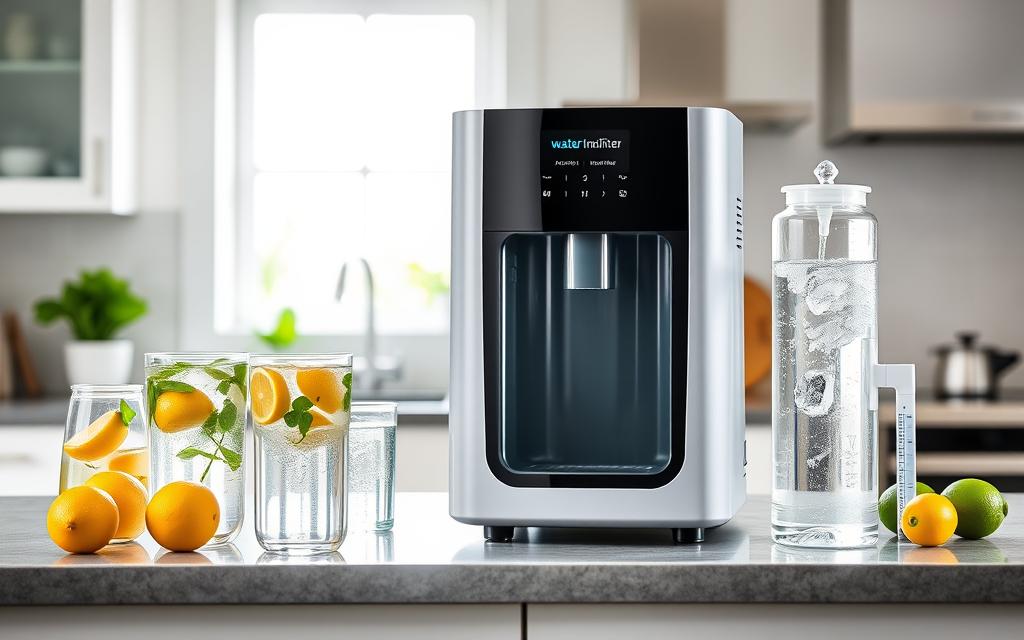

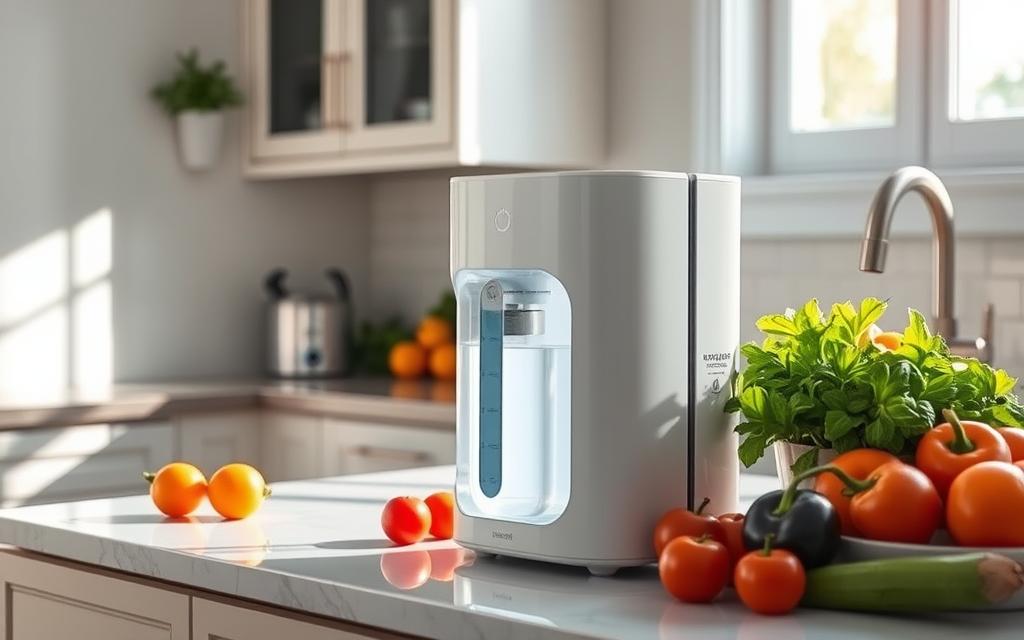
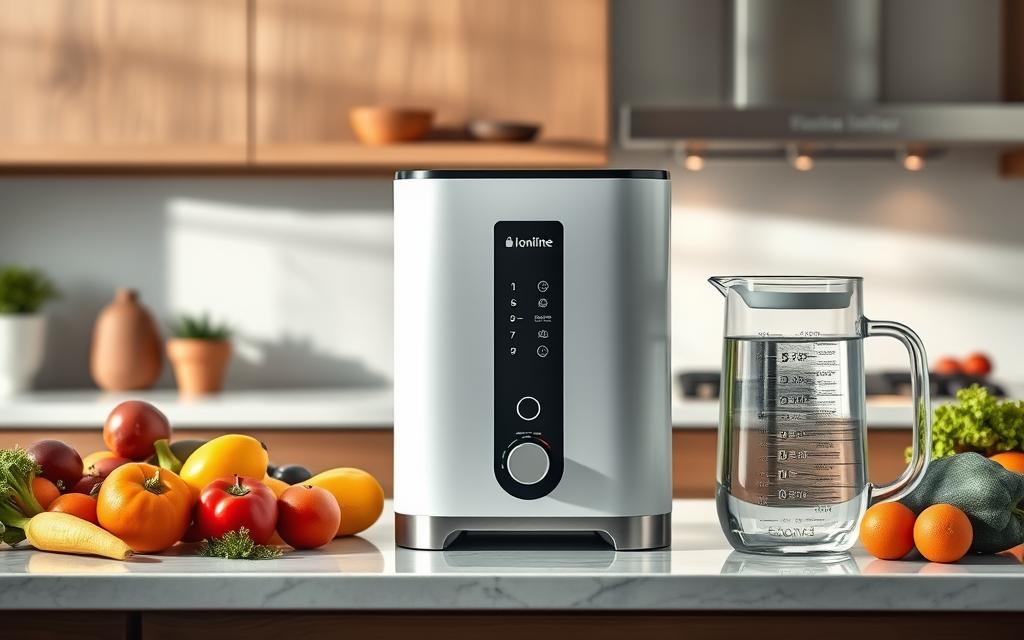
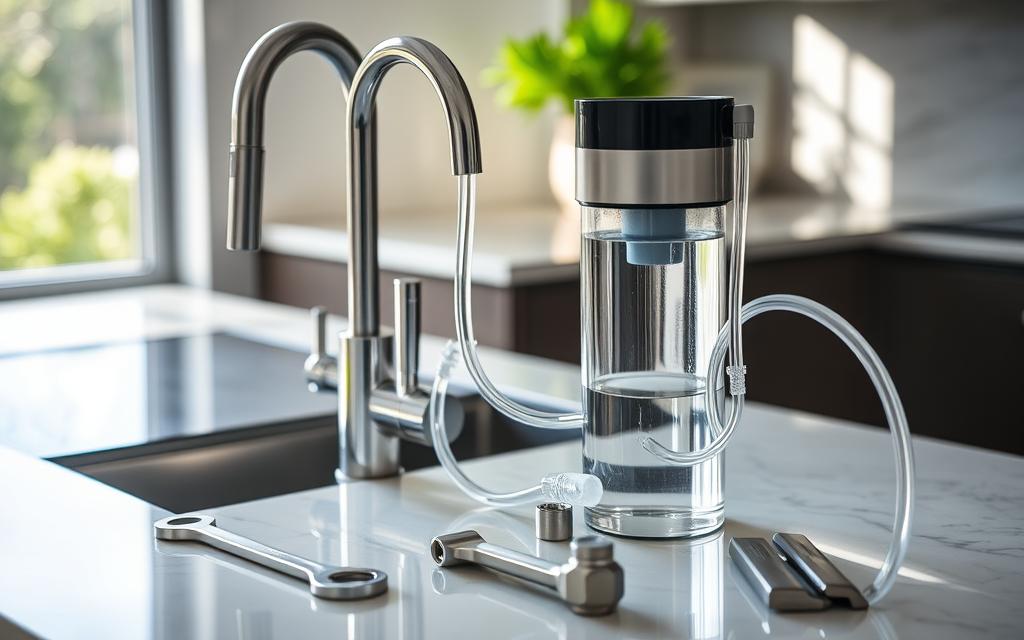
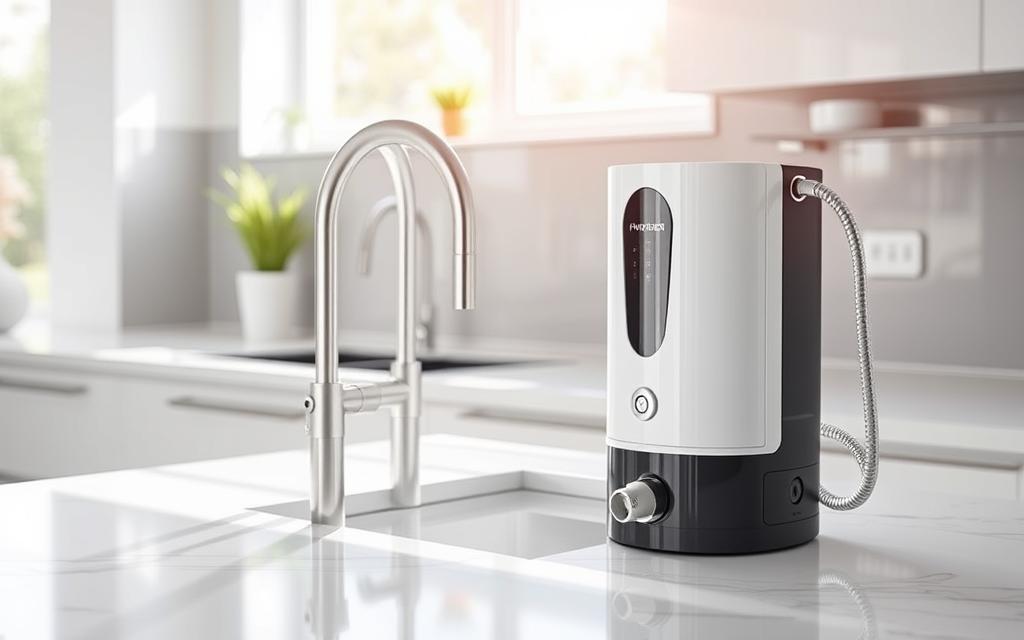
Leave a Reply